Category Archives: Success Stories
Elevating the Home Workspace: Composing with a New Level of Detail!
For many, the pandemic has brought time at home, and with that came investing in home studio setups. As the weeks passed by, the need for high quality sound reproduction rose as composers, creators, and engineers settled into their spaces. For Chad Heiny, a freelance composer and marching arts arranger, it meant taking a look at his needs and finding the perfect products for his space.
With a quick email to PreSonus Education Manager Evan Brown, the two discussed the space he works in, and quickly arrived on a solution that suited his needs, while allowing flexibility should he ever look to expand upon the setup. Heiny works heavily with percussion music, which requires accurate reproduction of subtle details due to the wide variety of timbres utilized in most modern compositions.
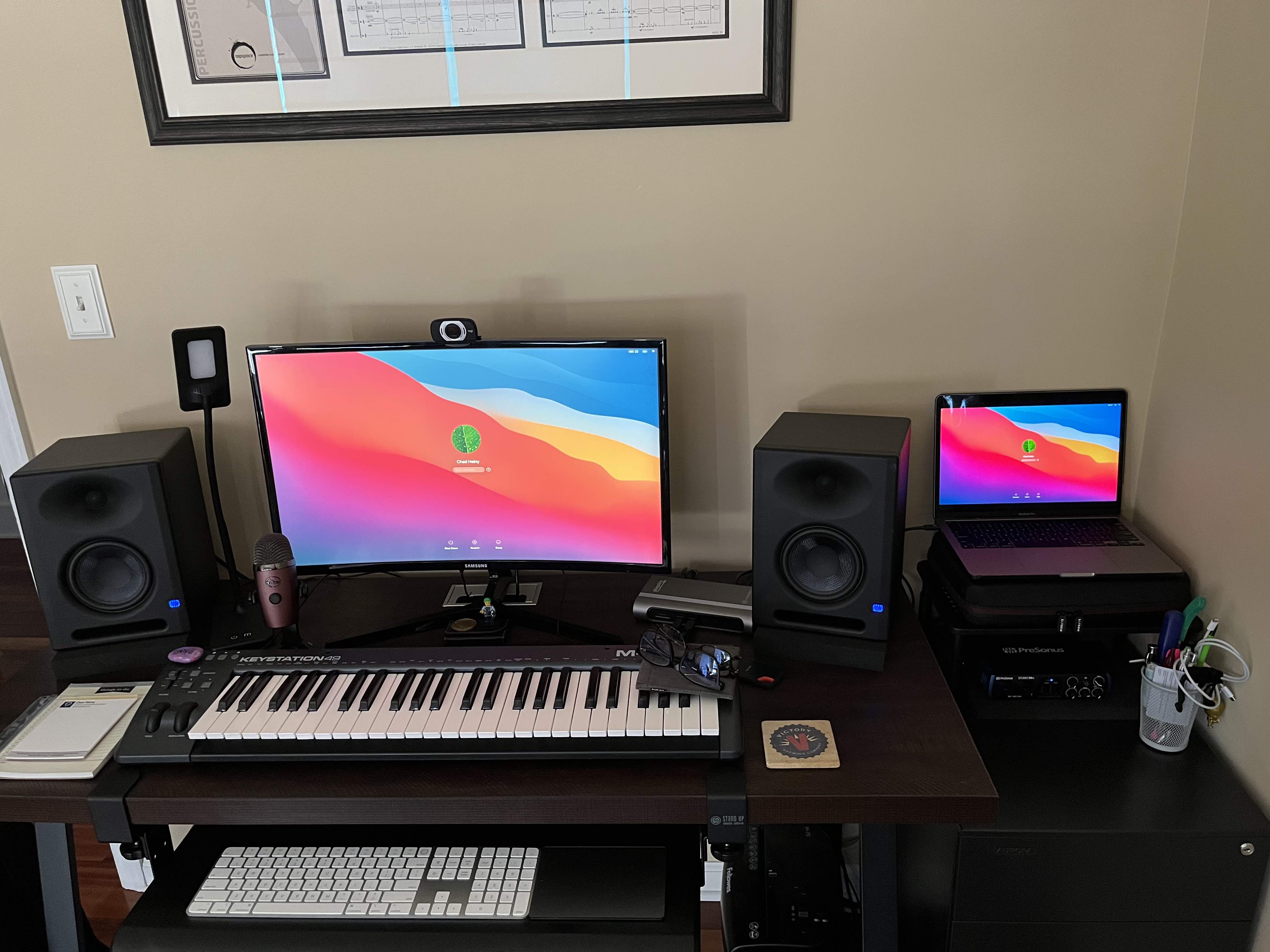
Choosing the Studio 24c audio interface for his audio input and output allowed Heiny to record and play back at sample rates up to 192k for crystal clear audio. The metering right on the front of the interface also allowed for a constant visual representation of the audio streaming into the unit for quick reference and adjustment.
To complement the interface, a pair of Eris E5 XT studio monitors were chosen for his space. With the acoustic tuning controls onboard the Eris monitors, Heiny was able to fine tune the units to his room quickly, allowing him to hear every frequency with a new level of clarity and detail. The EBM waveguides allow for a wider sweet spot, allowing him forgiveness in
“I love the front-end controls of the Studio 24c for quick adjustments to the volume in my space either when I am listening or recording. The Eris E5 XTs sound wonderful in my home office, and I loved the ability to dial them both in with even more detail through the acoustic tuning controls on the back of each monitor. I can’t say enough good things about the products and service at PreSonus!”
For more information on Chad Heiny and his work, Visit: https://chadheiny.com
On The Road Again: Phantom Regiment Trusts PreSonus for the 4th Season in a Row
After a hiatus in 2020, Drum Corps activity returned in the Summer of 2021. While tours were a bit shorter, move-ins started later, and some things may have seemed a little different, one thing is for sure: PreSonus equipment was found on the field again this past summer!
Our friends at Phantom Regiment, who have used PreSonus hardware and software since 2017, employed a full range of equipment including: a StudioLive Series III mixing ecosystem, CDL loudspeakers, ULT subwoofers, and Quantum audio interfaces. Their 2021 production “Harmonic Journey” brought an exciting mix of both acoustic and electronic sounds through their PreSonus setup.
At the heart of the setup, a StudioLive 64S digital mixer provided plenty of inputs to fit the needs of their performances, which include marimbas, vibraphones, synthesizers, hand percussion, and wireless microphones. Since setting up quickly is important in drum corps, a StudioLive 32R rack mixer in stagebox mode provided easy remote inputs on the field, all running to the main console via a single ethernet cable.

To deliver the highest audio quality to the audience, Phantom Regiment chose the CDL series hybrid array speakers in a two-box high LCR setup, which allowed for a smooth response across the entire frequency range—particularly in the midrange, where many instruments in the marching arts reside. To provide ample low end, five ULT18 subwoofers were utilized underneath the CDL speakers. The setup provided plenty of volume and enhanced clarity for the audience in every stadium they visited.
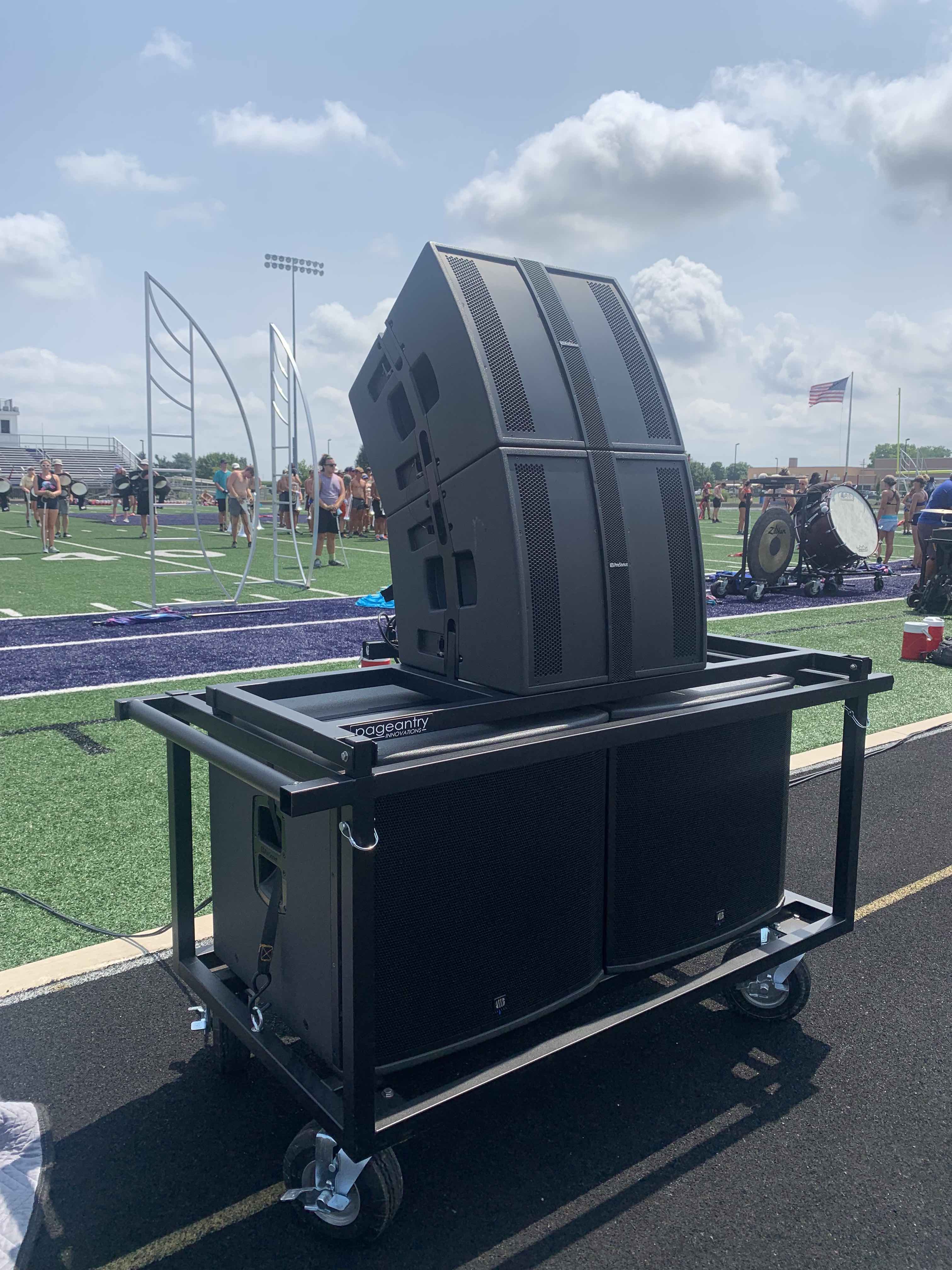
For the synth, a Mac Mini running Mainstage performance software fed into a Quantum 2626 audio interface, which then sent multiple outputs for synth patches, samples, and effects to the StudioLive 32R . The Quantum 2626’s Thunderbolt 3 connection ensured that pristine audio was delivered to the system with ultra-low latency. Since the Quantum 2626 is rack-mountable, it made for a clean, easily-organized setup in their beautiful Pageantry Innovations synth cart.
“Having the ability to be involved in every part of the process, from the gear selection to the audio design, I feel confident that the system far exceeded our expectations and left us with plenty of flexibility for whatever we needed to do for the 2021 production.” -Evan Brown, PreSonus Education Manager and Phantom Regiment’s Sound and Audio Designer
For more information on where you can find a drum corps show near you, visit www.dci.org
For more information on Phantom Regiment, visit www.regiment.org
Raising The Bar: The Modern College Percussion Studio
College percussion studios have certainly grown over time, and that growth doesn’t just include the growing instrument inventories in many of their studios across the globe—it also includes their inventory of audio equipment for recording lessons, music production, and livestreaming.
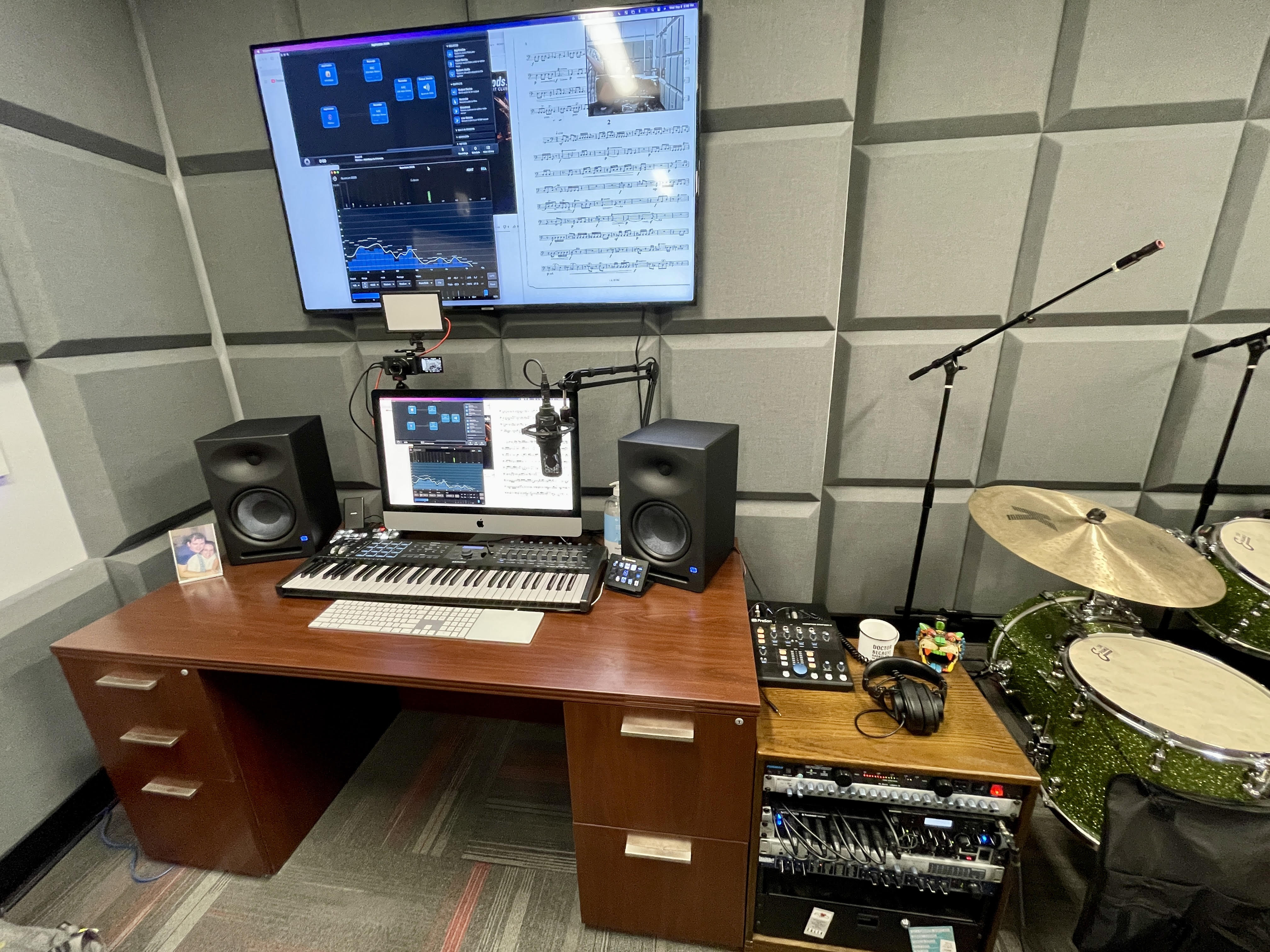
When he started at Jacksonville State University in the Fall of 2020, Dr. Matthew Jordan was tasked with outfitting their newly remodeled facilities right away, and selecting the right audio interfaces and studio monitors to mix and record audio was crucial in the process. Knowing the size of the space, Dr. Jordan knew that the monitors needed to be particularly accurate and forgiving.
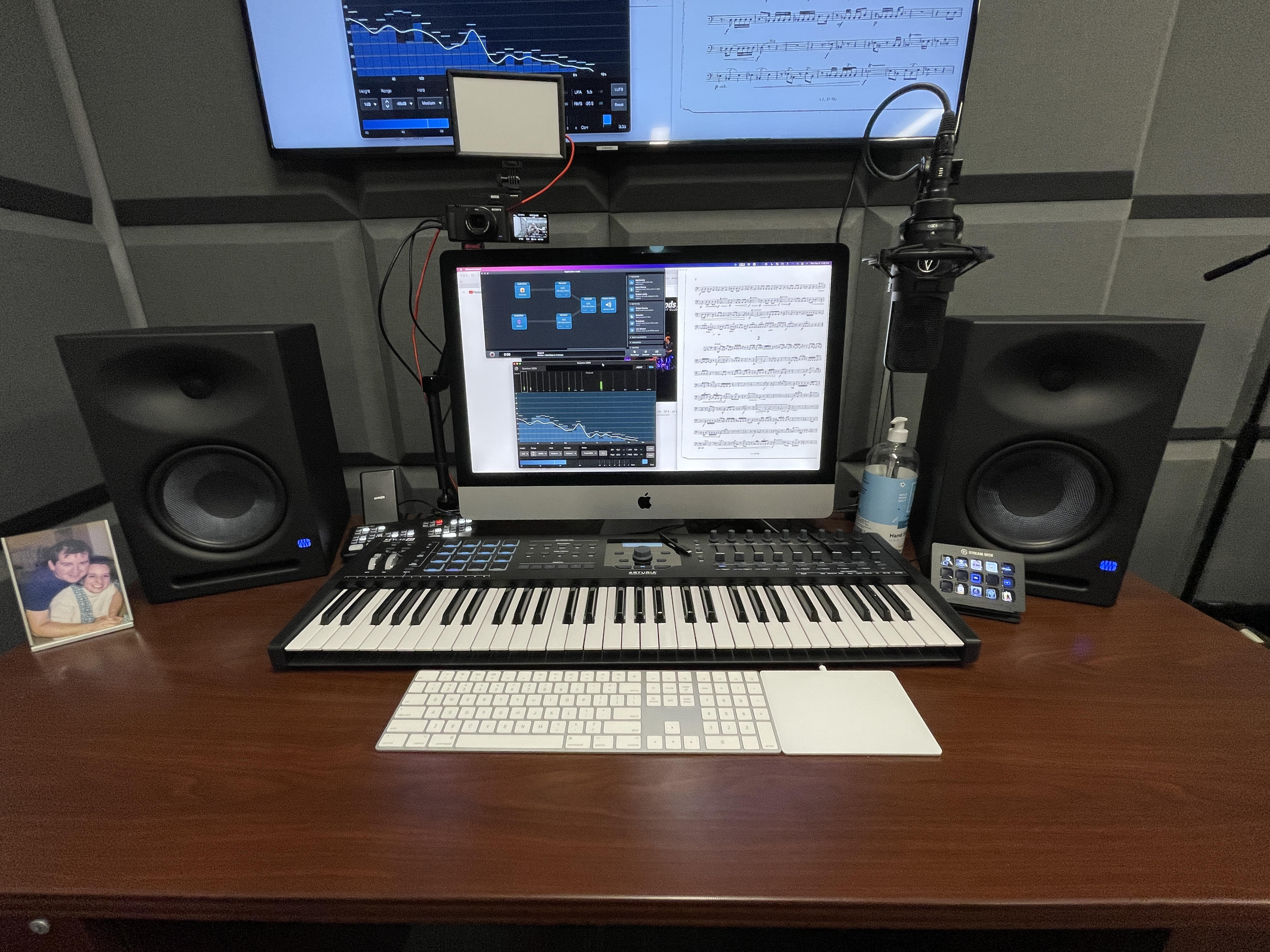
With that in mind, Dr. Jordan selected the Eris E8XT monitors and Temblor T10 subwoofer, which allow for a wide sweet spot in the mix environment and extended low frequencies, respectively. Both of which offer the level of detail and precision required when mixing percussion instruments such as timpani, concert bass drums, and the low range of marimbas. The Eris’ acoustic tuning controls allowed Dr. Jordan to compensate for the speakers’ placement, and he was able to quickly dial them in to suit the room. Additionally, a Monitor Station V2 monitor controller allows for quick volume control at his fingertips.

The studio plays host to a variety of uses, including lessons, juries, performances, and more. Due to the demands of the space, having multiple inputs available at a moments notice was a crucial need and the Quantum 2626 audio interface fit that need perfectly with plenty of onboard I/O as well as expansion options with ADAT including an existing Digimax D8 preamp to provide additional inputs. The Quantum 2626’s ability to provide pristine, low-latency audio over Thunderbolt 3 also allowed Dr. Jordan to provide plenty of outputs to headphones for students via an HP60 headphone amplifier.
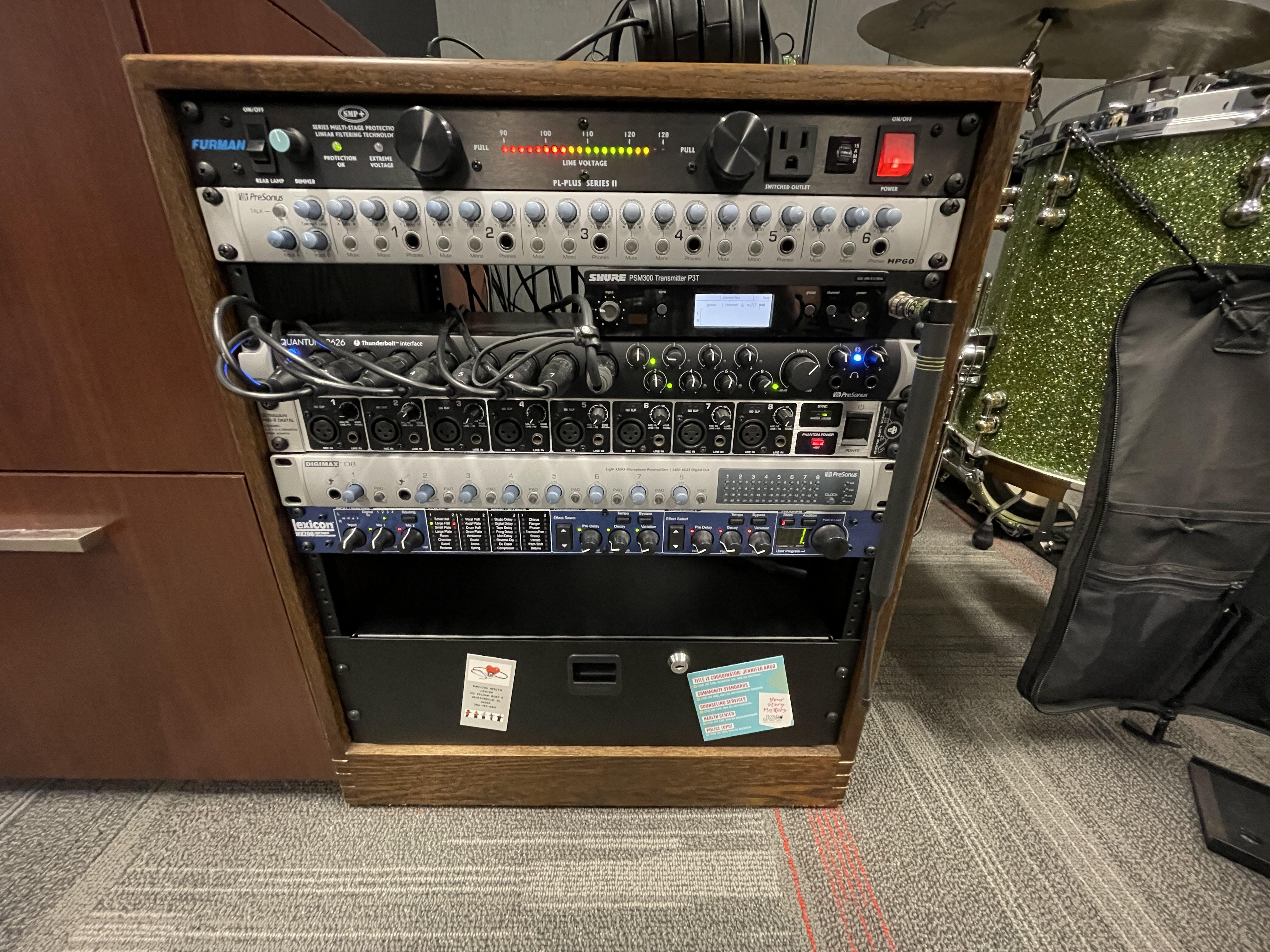
“I have been using Presonus products for over 10 years. My very first audio interface was a PreSonus FireStudio Project that I bought as a student, and I have continued to trust PreSonus products throughout all facets of my professional life. This latest set of equipment we purchased for JSU has enabled students to receive realtime feedback about their lessons, juries, and performances, as well as training to become the next generation of tech-forward performers and educators. I can’t wait to see what else our students can do with this wonderful equipment!” – Dr. Matthew Jordan
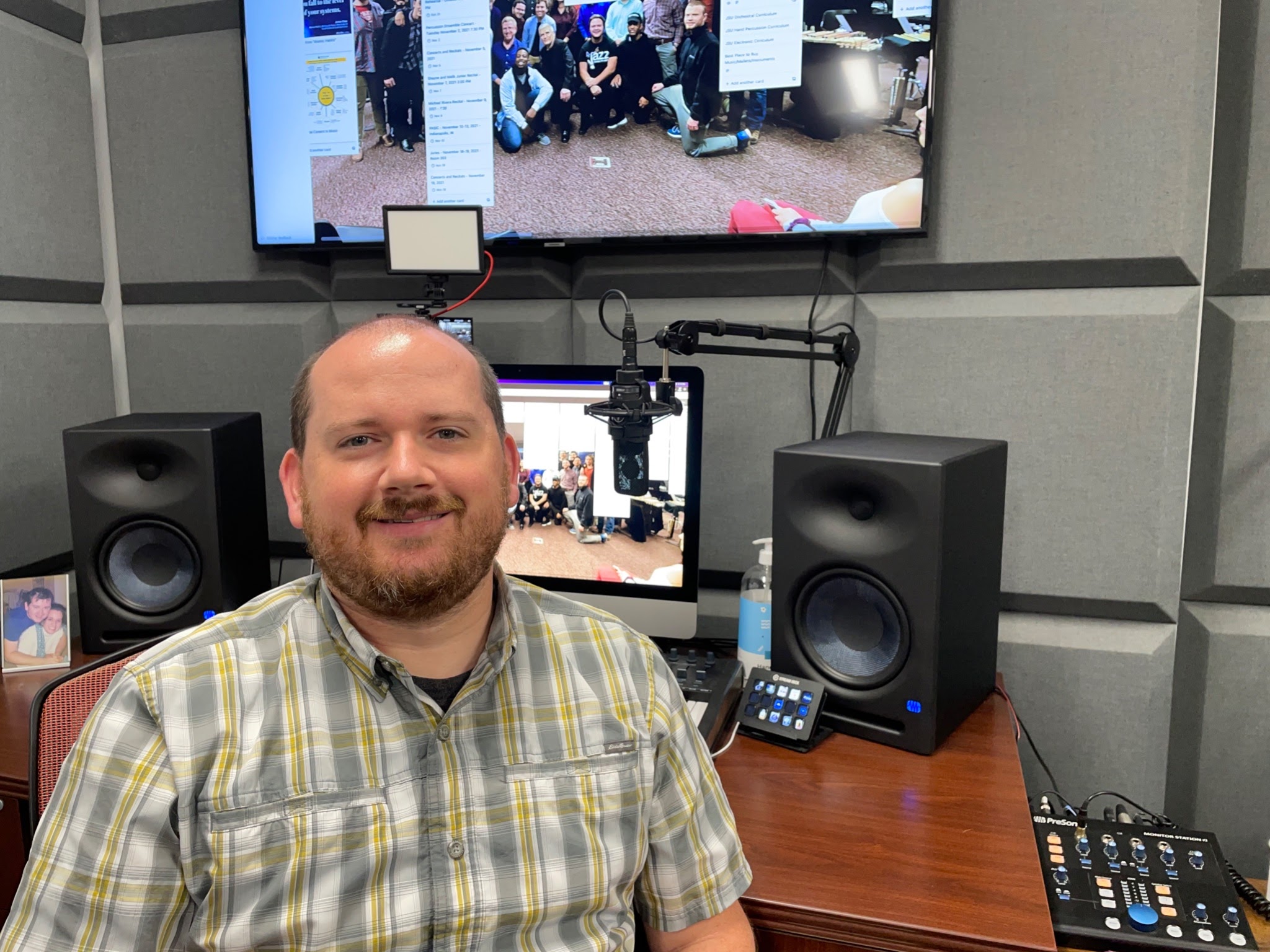
For more information of the JSU Percussion Program, visit: www.music.jsu.edu or https://www.facebook.com/JSUPerc
Christmas Came Early!
With many programs forced to cancel concerts or take alternate approaches, many have turned to a basic grid-style virtual ensemble as a solution. It’s typical for students to record their parts at home using a cell phone and a click track… but this project took it a step further! Tanner Leonardo used Studio One to create a next-level virtual ensemble for Lafayette High School (Lexington, KY). The process started by creating a click track to Leroy Anderson’s Sleigh Ride. Over fifty students then recorded their parts individually from the comfort of their homes and sent in their recordings.
Once the audio was separated from each video, the work in Studio One began. Each student was roughly aligned to a clap-sync then finely aligned by using many cross-fades at the beginnings and ends of phrases. This first level of alignment was done to match each student with the click-track. The recordings were then grouped by instrumentation and aligned to their section. The final macro-alignment was completed by isolating Bus sends for each instrument group and matching them with the other instruments.
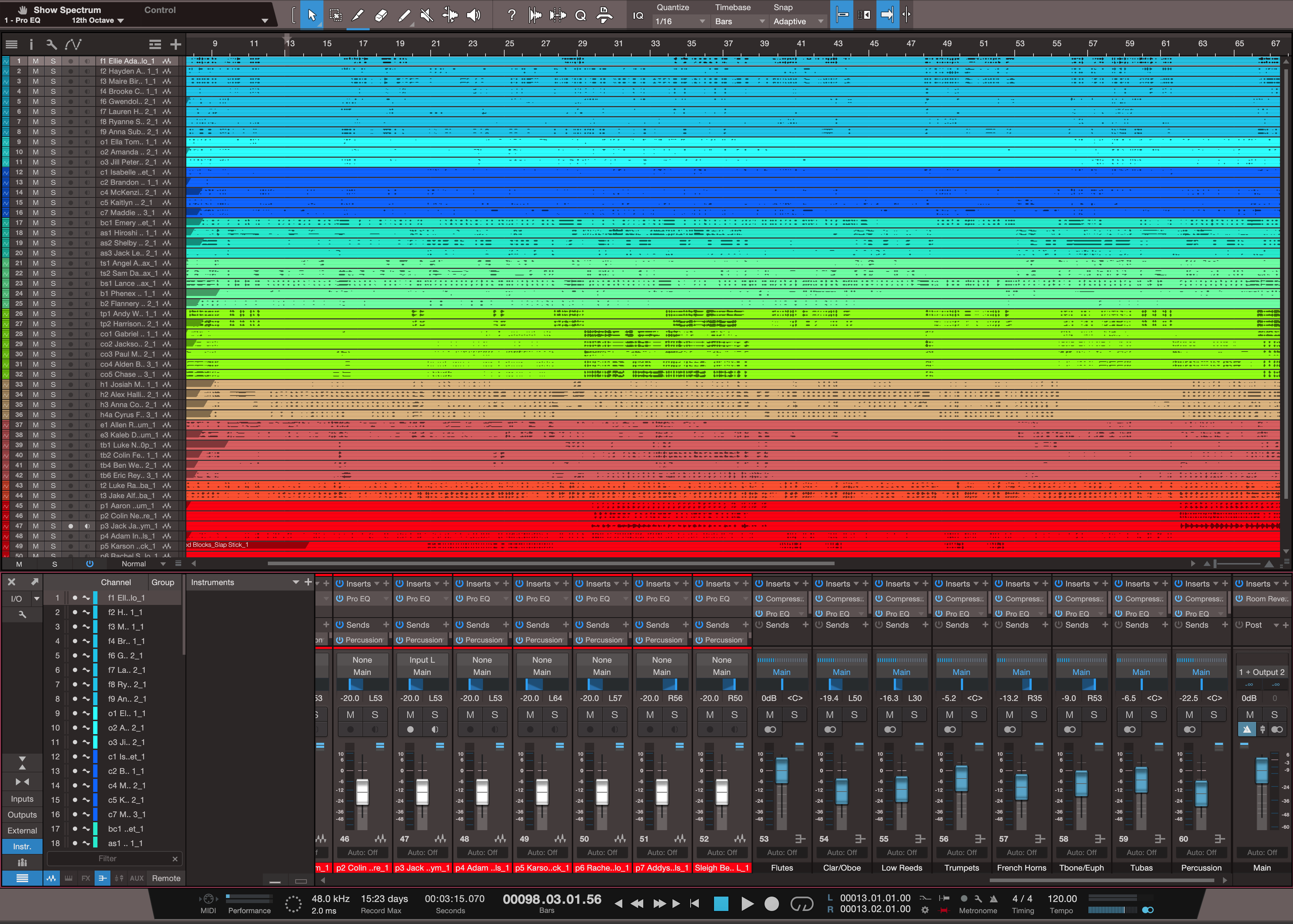
Studio One’s Pro EQ plugin allowed Leonardo to make sure each instrument would sit well within its own frequency range, while also allowing for the removal of any computer fans or dogs barking in the background. Random channel-level panning was added to spread the instruments across the stage and more specific Bus-level panning was used to place instruments in their corresponding stage location.
Once the tracks were aligned and balanced, Pro EQ and Compressor were used on Bus Sends to help further place each instrument in their corresponding frequency and dynamic range. A soft plate reverb was created in the Room Reverb plugin on each Bus at different levels depending on the density of of the scoring at any moment. Finally, another Room Reverb was added on the Main Out to place the instruments into a virtual concert hall.
The video was created by using Final Cut Pro. Each video was aligned using both the clap-sync and specific individual transitional cuts. The forest and snow were created using stock assets, and layered according to their entry in the production. The ornaments were created by cutting a circle mask on each video and adding the ornament toppers using layering within Compound Clips. The videos were then faded in and out according to when they play on screen. The final production was created by key-framing the virtual camera around the screen to see students up close.

This production style will be recreated at the 2021 Percussive Arts Society International Conference in Tanner’s clinic titled “Virtual Ensembles: In a Post-COVID World!”
Thanks to the Lafayette High School Band for their great performance and thanks to Tanner for sharing this with us!
Swinging with a New Level of Clarity
North Allegheny High School Jazz Ensemble scores a PreSonus Sound System
Jazz continues to thrive, while its place in music education does the same. Over time, finding solutions to improve the delivery of this musical art form have evolved, and PreSonus is thrilled to offer products that help bring jazz to life.
In the spring of 2020, with the help of a grant from the Ryan McCutcheon Rhythm 19 Fund, the North Allegheny High School band program brought home a new portable jazz sound system for their four jazz ensembles to use for both for concerts and recording. Consulting with their local retailer and PreSonus Education Manager Evan Brown, they were able to identify their needs, selecting the StudioLive 16R digital rack mixer and AIR series loudspeakers for the project.
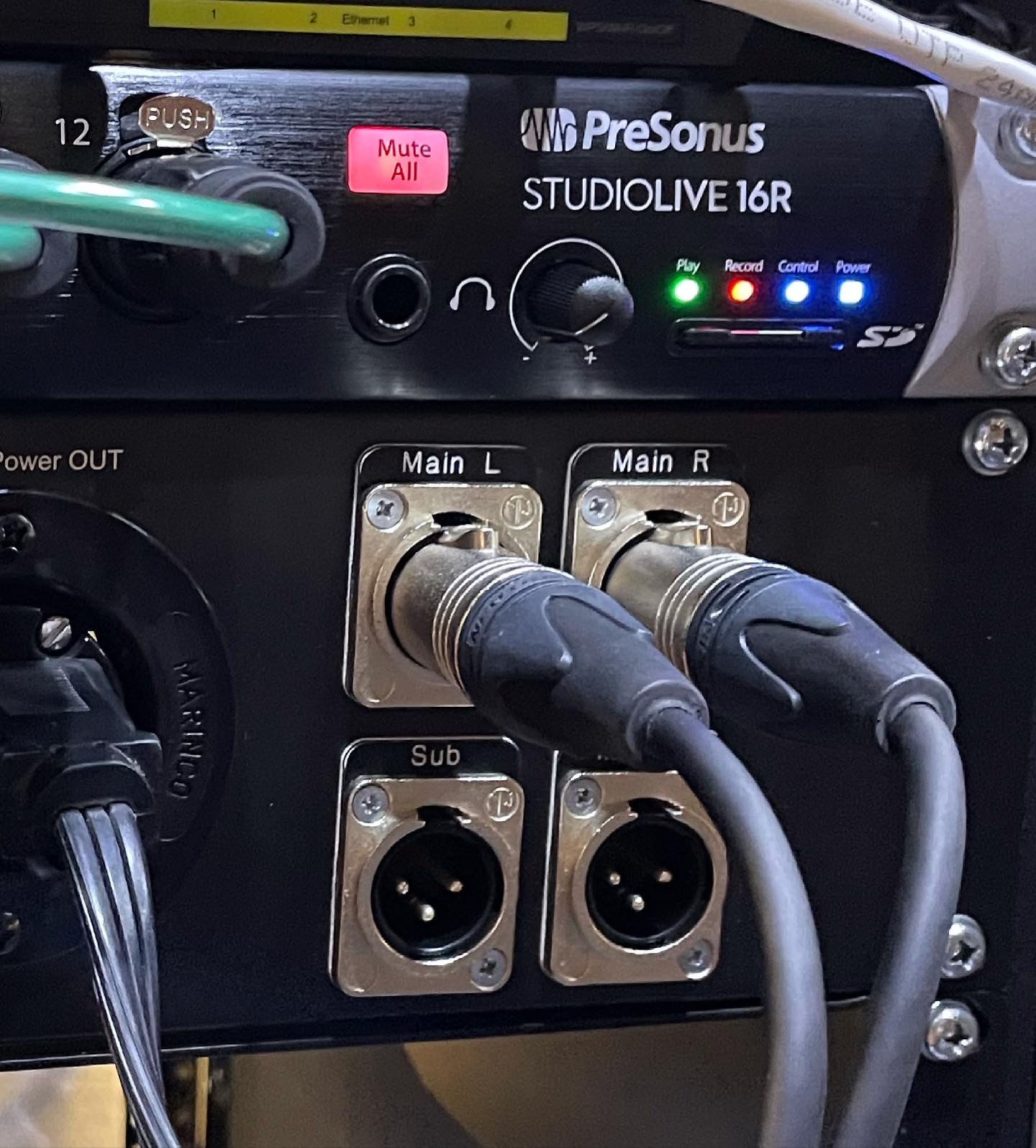
Shortly after delivery, the pandemic arrived, delaying the first concert for the groups for over a year. In May of 2021, the system was finally put to use, and the accolades started coming in on how it changed the band!
By selecting the StudioLive 16R, North Allegheny got 16 mic preamps at their disposal to accommodate their input list of clip-on mics for the saxes, solo mics in the trombone section, and direct input lines for bass, guitar, and keyboard. Since the 16R is a rack mixer, all that was required to mix was a basic wireless router and a tablet. Additionally, the 16R allows for onboard stereo recording to an SD card, and multitrack recording via PreSonus Capture software. This gave them the flexibility to perform while recording everything in real time for review and post-production.
Equally crucial, the AIR series loudspeakers were selected due to their powerful and lightweight design. Utilizing two AIR15s as mains and an additional AIR10 for a vocalist monitor, the speakers provide plenty of volume and coverage for North Allegheny’s needs, which demanded the wide spread of 90 degrees from the horns. Furthermore, the AIR series are also lightweight enough to make the frequent relocation of the entire system less of a chore; venues include indoor auditoriums, cafeterias, outdoor parks, and amphitheatres. While the system is well-suited to these environments, there are plenty of possibilities for expansion down the road via AIR subwoofers or additional monitors.
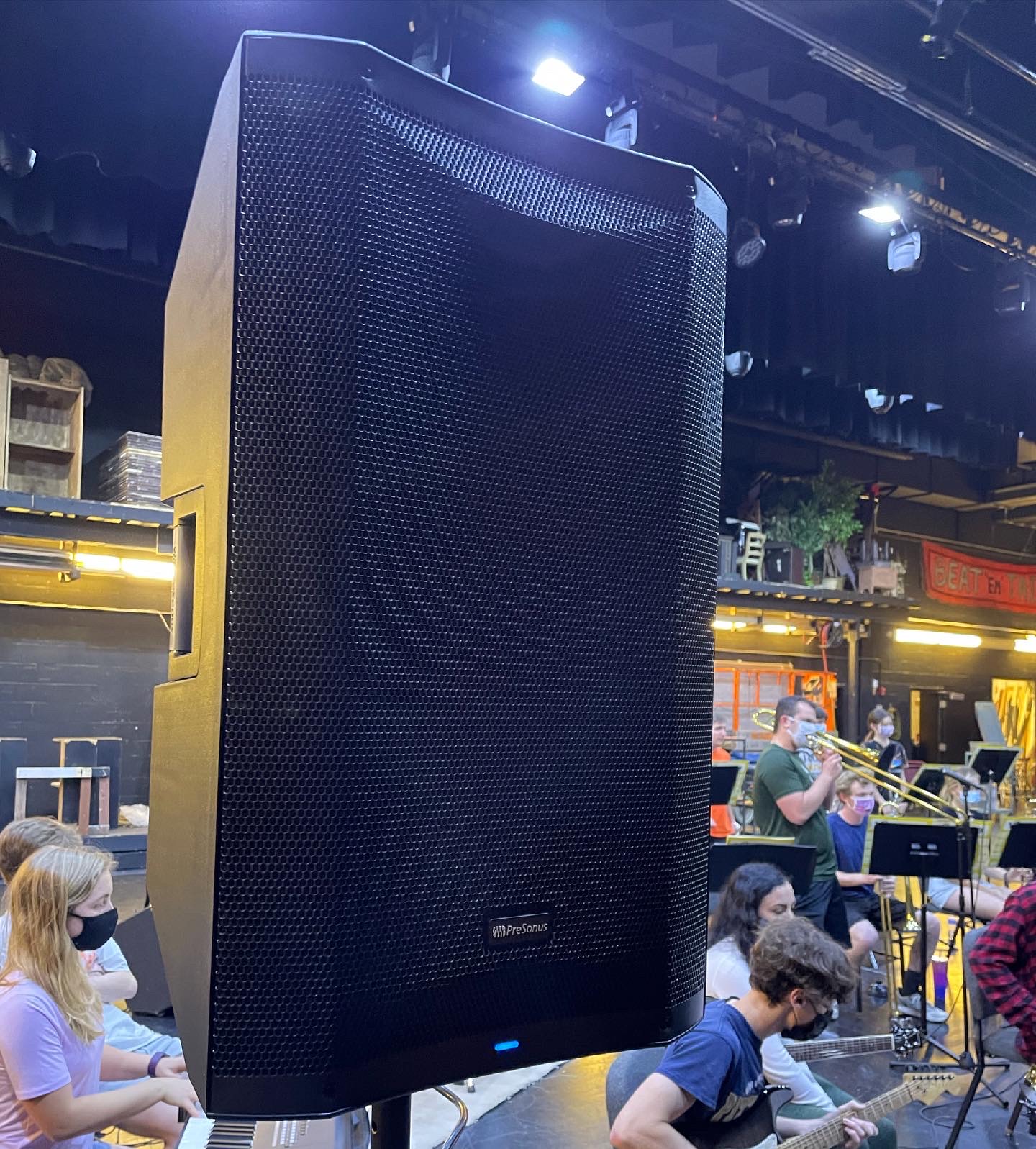
“Hearing the difference in the clarity of each ensemble was a total game changer. It made me a believer that technology can improve and enhance the work we do with our student ensembles in the classroom,” said Steve Baldanzi, Associate Director of Bands at North Allegheny.
Baldanzi co-directs the jazz programs, sharing the duties and splitting the ensembles with head director Todd Stefan.
For more information on the North Allegheny Band Programs, visit www.naband.org
On the Move: The Mobile Music Room
Over time, we’ve seen many changes to the “traditional” classroom. With the return of school in the fall of 2020, many teachers have found themselves in new scenarios in light of the COVID-19 pandemic. For Matt Filosa, it meant taking his classroom experience and packing it into a cart.
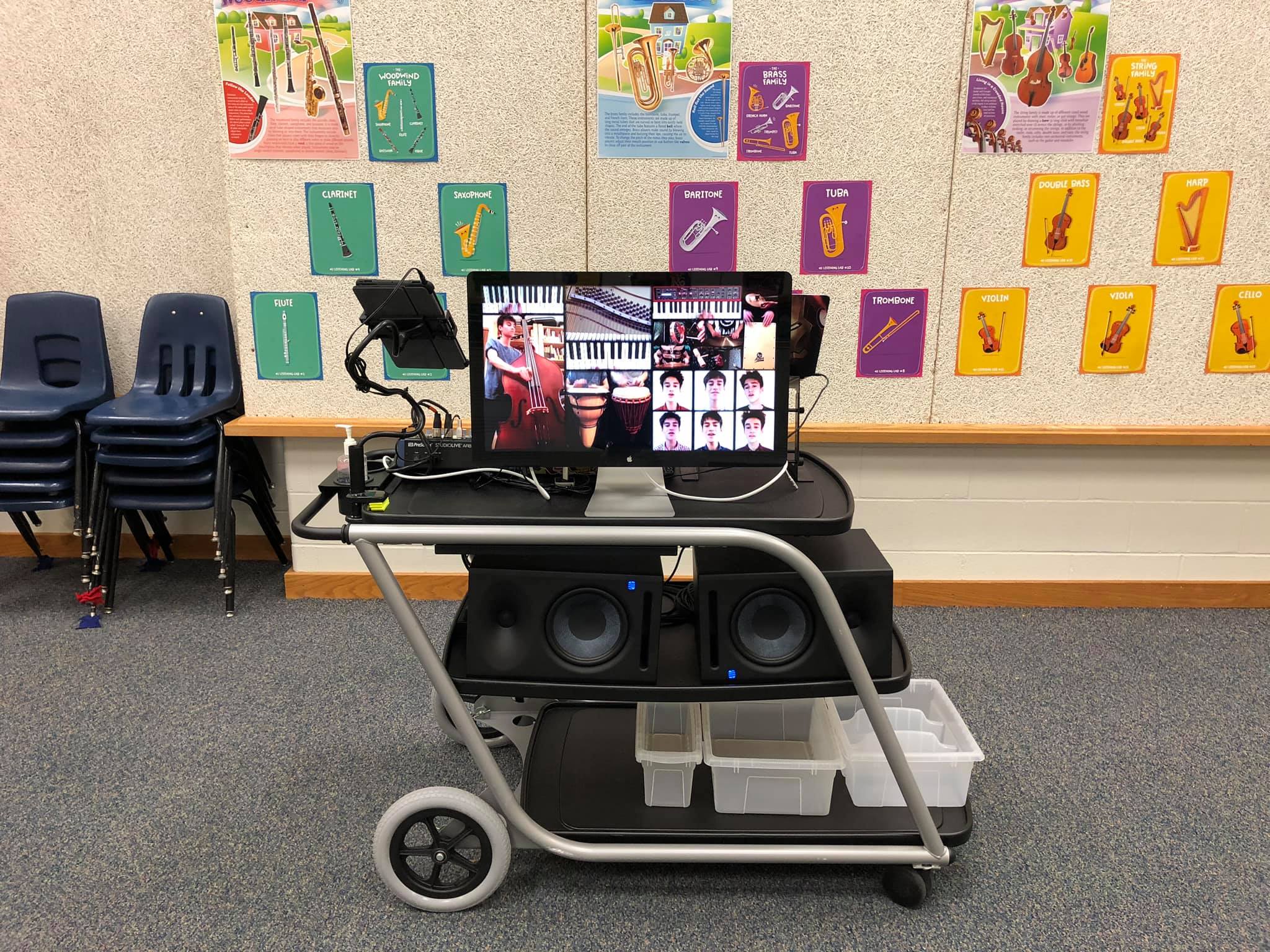
Filosa, in his first year in a new teaching job, is a Music Specialist at Southridge Elementary School in Lewisville ISD, TX.
In fall of 2020, the pandemic ushered in a wave of new ideas about how music classes would be taught. This led Matt to get creative with delivering a great experience to his students. With the help of a PreSonus StudioLive AR8c hybrid mixer/audio interface and Eris 8XT monitors, he was able to bring that reality to life.
“Faced with the challenge of teaching from a teacher cart this year, I was in search of an all-in-one solution to integrating technology into my cart. I needed an interface that would have a small footprint and allow for extreme ease of use. The PreSonus StudioLive AR8c has been the perfect piece of hardware, providing me with a variety of input and output options. This has allowed me to seamlessly switch/control audio between a variety of devices. The AR8c’s physical setup and controls allow for easy, on-the-fly adjustments, without detracting my attention away from teaching.
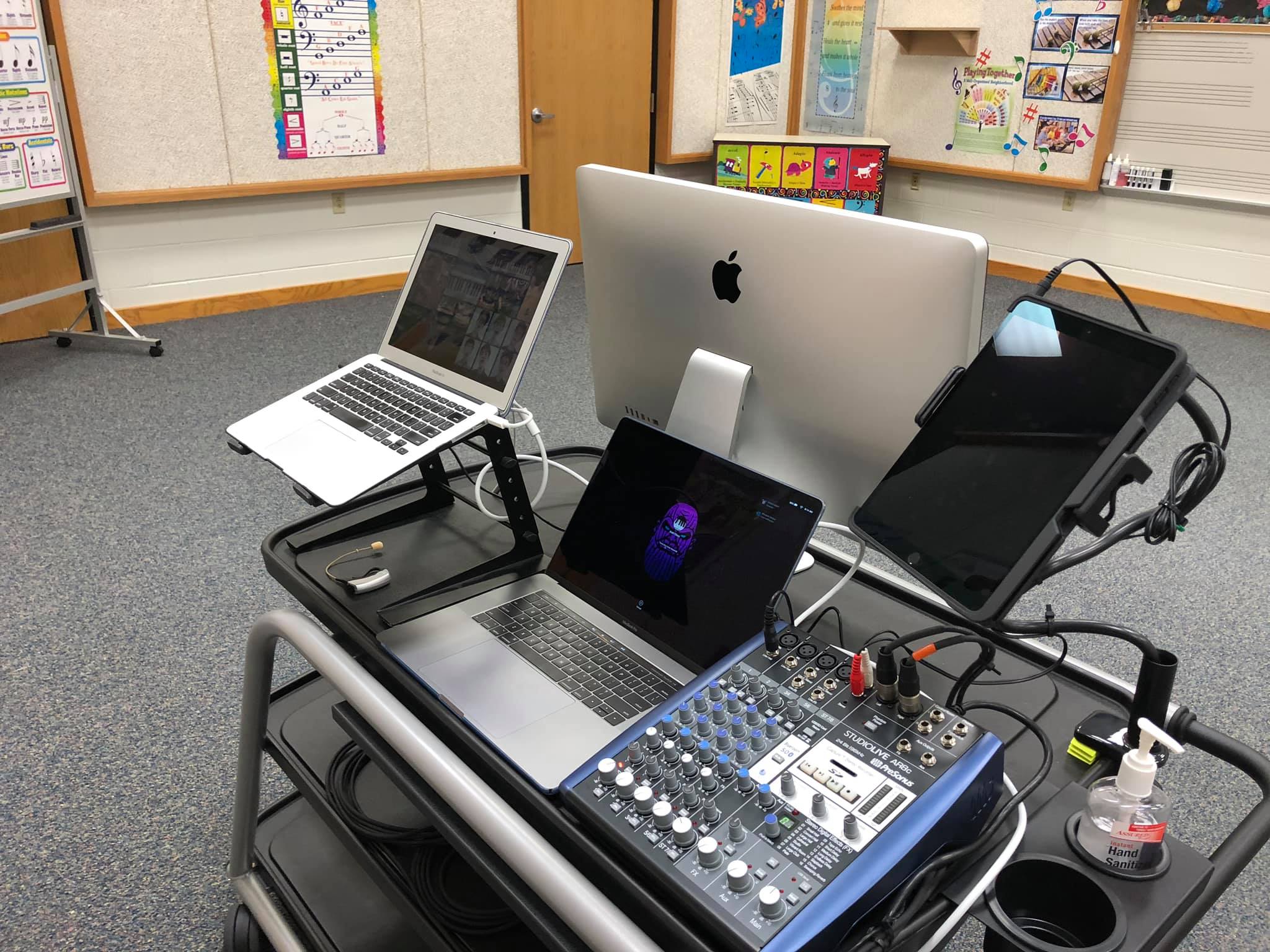
In combination with the AR8c, the Eris 8XT monitors provide my students with superb, clear and crisp audio at all frequency ranges. The PreSonus AR8c and Eris 8XT are the perfect synergy of equipment for any level of educator looking for intuitive technology to improve upon how information is delivered to students.” -Matt Filosa, Music Specialist, Southridge Elementary
Atlantic Idol with Hoot/Wisdom Recordings
This spring, PreSonus was proud to partner with Hoot/Wisdom Recordings, the on-campus record label of Florida Atlantic University in supporting their second season of the Atlantic Idol student competition!
PreSonus Education Market Manager Evan Brown got a quick chance to catch up with Camie Wheeler, the labels Vice-President to hear more about this years contest. “With the contest open to FAU students and alumni, we received over 25 entries, which was a great success given the nature of the pandemic. With the help of PreSonus, we were able to provide our winner with an AudioBox Studio Ultimate Bundle, which will help them to continue to create high-quality music.”
From all of us at PreSonus, Congratulations to all of the participants on a job well done!
For more information on Hoot/Wisdom Recordings, visit: https://www.hootwisdom.com/
Guest Blog: Teaching Game Music with Nikola Nikita Jeremić!
In this blog, we hear from PreSonus Artist Nikola Nikita Jeremić and his unique game design course at SAE Institute Belgrade!
If you have ever wondered how music for games is made, then SAE Institute in Belgrade, Serbia is the place to go! PreSonus and SAE Institute Belgrade have partnered together to bring the best audio tools for everyone who’s attending Nik’s course.
The person who will teach you about the exotic world of interactive game music, is none other than PreSonus artist, Nikola Nikita Jeremić. You may have read our interviews with him about his creative approaches to his soundtracks for Starpoint Gemini series of games, so Nikita decided to gather all of his vast experience on this subject and create two 2-month courses on how to compose game music from start to finish.
Nikita approached PreSonus on behalf of SAE Institute in Belgrade with desire to teach his lessons in Studio One, so we were more than happy to provide Studio One licenses for all of his students at the course so they can use them from the comfort of their home studios.

The course is divided in two parts, basic and advanced, and each one is two months long. The lessons are held online via Zoom due to the COVID-19 pandemic.
The basic course concentrates on basics of game music production and vertical layering, but also serves as the training course of basics of music production in Studio One and all of the benefits that Studio One offers to composers working in game and film industry. The course is based more around practical lessons than theoretical approach, so students have a hands-on experience on how to create their own interactive game soundtrack in its basic form and how to implement it via audio middleware.
The advanced course is expanding on the subject of the basic course and going really deep into the advanced techniques of how to create your own composing and mixing template in Studio One, specifically for game music production, with even more practical example on virtual orchestration and hybrid music composition and sound designed elements.
After each course, students are required to create their own compositions by using virtual and live instruments, edit the tracks, mix them and prepare them for implementation via audio middleware in order to get their licensed certificates from SAE Institute.
This is the first course of its kind at SAE Institute Belgrade, since June there are already 11 graduates of basic course, and now, starting from 17th of September, there are 18 students attending the advanced course.
All of us at PreSonus are looking forward to more graduates from SAE Institute who will become game music professionals on Studio One, and we are happy to be a part of their education!
Guest Blog: Solving Remote Teaching with Mats Nermark
- a pdf with ”Getting Started” instructions
- pdf sheet music with standard notation and tab
- a recorded version of the tune
- the same tune ”minus 1” to use a s a backing track (see more later)
- a video where I explain the different steps in this particular lesson package
- 1. First I have selected a tune with a fairly simple melody that every one can play as long as they can read a tab.
- And everybody should learn how to play simple melodies with expression and phrasing. You can’t get enough of that in my book.
- 2. A simple strumming accompaniment
- 3. A more advanced strumming accompaniment
- 4. A finger picking or stylistically appropriate accompaniment
- 5. Improvisation, what notes you can use and why. Stylistic tips and trick. This ties in with music theory, knowing your scales and how chords are constructed, etc.
Here is an example of one lesson pack broken down! (Lesson Example Files: Click Here)
- Step 1: For example, I selected Freight Train in C. Simple melody enough for the beginner to get around but also a good base on which to start a discussion with the advanced students about phrasing and the importance of the pause and space.
- Step 2: It also a song that’s easy to strum around a camp fire when camping, so we introduce basic strumming.
- Step 3: I then created the backing track as a country tune which allows for some more advanced strumming.
- Step 4: This brings in comping in the style of Luther Perkins who was the guitar player with Johnny Cash for many years.
- Step 5: This is unlimited in scope as there’s improvisation in the country context with stylistic elements like chicken picking, double stops, playing in sixths, and the importance of practice alternate picking.
Thanks again to Mats for contributing! For More on Mats Nermark, Visit his website at: www.nermark.com
Interested in submitting a guest blog? Contact us at musiced@presonus.com
Live Streaming with an AR or ARc Mixer!
With the StudioLive AR and ARc mixers being popular with music teachers across the globe, the current shift to online streaming as a means for teaching is rapidly growing due to the current COVID-19 pandemic. Our friend Gregor has put together this fantastic video showing you how to put together a simple livestream utilizing OBS and a StudioLive AR or ARc Series Hybrid Mixer/Interface!